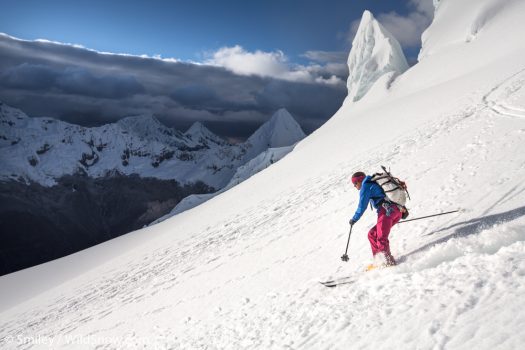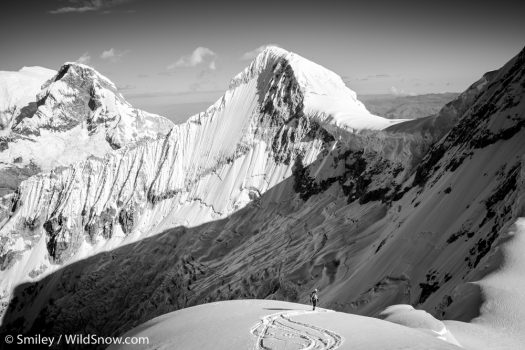
Ski mountaineering in the Huandoy group of Peru’s Cordillera Blanca. Guest Blogger Jed Porter tracing the first turns that Huandoy Este has likely ever seen.
I’m obsessed with Google Earth. What did we do to procrastinate at our desks before satellite imagery? One of the coolest things about viewing satellite imagery is seeing the big picture in which our mountain landscapes sit. Colorado’s ‘other half’ is readily apparent from way up high. The pimples that are Washington’s volcano chain jump right out at you. The northern half of South America is a wild land of extremes from 4000 miles up. The Amazon, and its jungle and tributaries, is the dominant feature. Mountain lovers will immediately notice the less green and more jagged landscape rimming the continent on the west. From a thousand miles up the landscape is largely brown and dry. However, scrolling up and down the Andes from the exosphere, blotches of snow and ice are apparent, impossibly close to the equator, there in the middle of Peru.

Climbing for turns, with the entire surrounding region otherwise occupied. To the east is the Amazon rainforest and to the west along Peru’s arid coast, the scene and terrain is anything but alpine.
The Cordillera Blanca stands out as an island of alpinism in a giant sea of jungle, desert, and agriculture. This alone makes skiing in Peru special. One can be quite confident that no one for thousands of miles is doing what you are doing. Maybe they are the smart ones, but you, at that moment at least, are the special one.
Friends Mark and Janelle Smiley and myself went to Peru to climb mountains and ski back down them. It seems that a handful of the thousands of visiting climbers each year bring skis to the Cordillera Blanca. I think that ratio should change. In a sort of exploratory bid, we camped high, ‘epic-ed’ a little, scored a first known descent, and enjoyed an amazing run on a classic slogging climb.
We began our ski trip at least somewhat acclimated from respective guiding missions. I had spent three weeks in the Ishinca Valley teaching advanced mountaineering skills while the Smileys were fresh off Alpamayo. This preparation allowed us to scoot right up to the Pisco-Huandoy ‘Moraine Camp’ at over 15,000 feet. Our mission from there was Huandoy Este (6070m). Not knowing exactly how long things may take us, we carried our camping gear with us up toward the saddle between the main Huandoy peak (Huandoy Norte, or North) and Huandoy Este (East). The day from Moraine Camp to our saddle camp was long, high, and hard. We encountered crevasses, a barely-seen, and uncomfortably close pre-dawn serac avalanche, a few pitches of steep ice, and a final, logic-defying overhanging rappel to commit to the camp and peak.
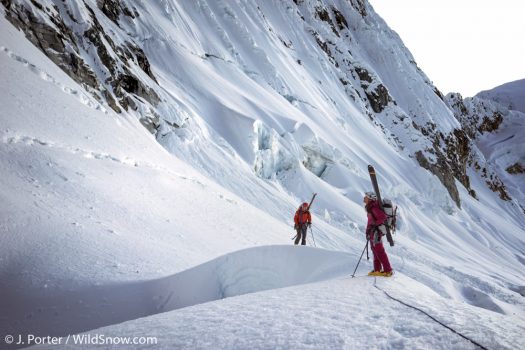
First light and Mark and Janelle on the glacier beneath the SE face of Huandoy Este. Thirty minutes before this photo we raced, roped-up and post-holing, from a roaring powder cloud in the first moments of daylight. You can see the debris pile behind Janelle’s purple pants and, faintly, our boot track behind her heels. Not all of that debris is from this morning’s slide.
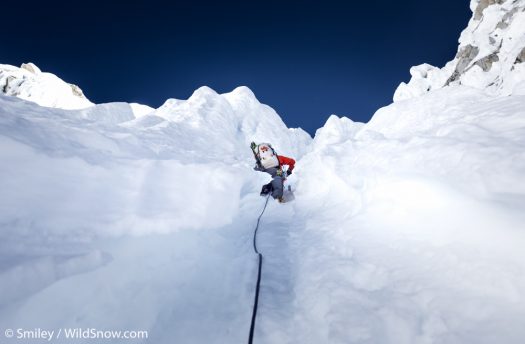
Mark putting the ‘mountaineering’ in ski mountaineering. Climbing 75 degree ice runnels, with skis on one’s back, is no picnic. Every turn of the shoulders jabs a tip. That’s annoying on its own, but the shower of snow down the back of your neck is the sting in the tail. We finished these pitches, all at almost 19,000 feet mind you, soaked, cold, and worked.
That rappel was a cruel joke. All our scouting and research (did I tell you I dig Google Earth?) had suggested we were climbing up the steep side and would belly flop onto the gentle top of a hanging glacier perched on the other side. Familiarity with the “rhythm” of Peruvian terrain supported this hypothesis.
We were half right. There is indeed a gently sloped glacier heading north from that saddle. However, for whatever reason, it is guarded by a 30m steep wall and 5-10m perennial cornice. Peruvian cornices are strange beasts. Higher latitude, “seasonal” cornices are fragile and moody. Those in the Blanca are rock hard, mainly permanent features. I suspect that, should anyone look to replicate our silly mission in Peru, they’ll find the same sort of obstacle for years to come. The good news is that one can pretty reliably rappel off and hang out under said cornices. The bad news is that you’re never going to cut it off nor can you “tunnel through” nor can you hope it will fall off to allow your return passage. We rapped north from a natural bollard the size of a school bus. Skinny ropes, puffy clothes, overnight packs, and skis aren’t normal associations with overhanging rappels. What a strange, strenuous, committing rappel.

Mark, touching down after the cornice rappel. Just a few more meters of down climbing brought us all to basically flat ground.
After the eventful arrival to the 19,000 foot saddle, we dropped our camping stuff, skinned mellow terrain through crusty facets to the summit of Huandoy Este, and skied back to crash out. You don’t really sleep at 19000 feet. At least, you don’t really sleep at that altitude when you’re acclimated to 14000 feet or so. Nor do you sleep when you are obsessing about the realities of reversing a giant equatorial cornice. We spent the entirety of that third day engineering our exit over the cornice. We left our camping gear behind, finding a sort of break in the cornicing to zig and zag through. We then worked along the ridge crest for a bit, back to the saddle itself. We stashed some stuff there, fixed the rope, and rappelled back to our camp.
The fourth morning we were able to ascend the fixed rope and work our way back down the runnelled ice face. A few steep turns above the ‘schrund preceded some final, thicker-aired railing corn turns beneath overhanging hazard. We even rappelled off the toe of the glacier to dry ground. By the end of the endeavor, four days and 7000 feet of gain later, we had probably skied for about an hour and 3000 vertical feet… Not a great ratio. If you’re looking for the sexy side of first ascent, big mountain ski mountaineering, this isn’t your tale. If you’re after adventure and exotic turns, we have some more ideas for you.
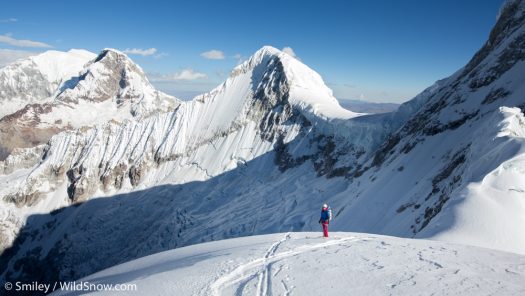
Skiing on the upper reaches of Huandoy Este was crusty facets and wind pillows. But at least we were on super skinny skis and exhausted from the 6000m altitude…
That fourth day we were back on solid ground by about 10am. The tropical days are all about 12 hours long, all year long. We had extra energy, time to spare, and lightweight ski gear. We were chilling again at moraine camp in awesome mid-day sun. This moraine camp is primarily inhabited by those pursuing the classic ascent of Nevado Pisco (5752m). Pisco on its own is a common objective for visiting climbers.
With the time, energy, and wherewithal, we raced out a quick summit and ski of Pisco that fourth afternoon. We doubled our ski vertical for the trip, with about four hours of effort. That, my friends, was civilized skiing in an exotic locale. The descent of Pisco is worth repeating. Huandoy Este is serious mountaineering skiing, while Pisco is cruiser adventure turning. The altitude makes it strenuous, and there’s always the chance of tough snow conditions on big mountains, but Pisco is a pretty reliable ski peak.
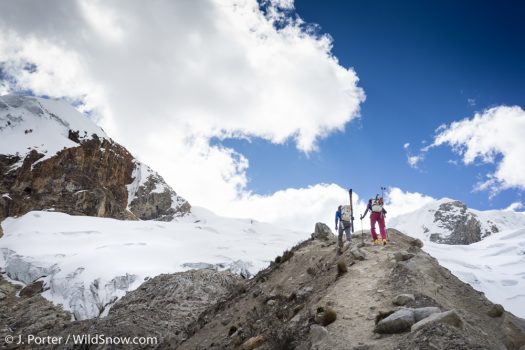
Mark and Janelle approaching the toe of the Nevada Pisco glacier. Pisco is home to ski lines extreme and mellow. We opted for the gentle, glaciated evening tour option.
There is little that soothes the soul after a full-on mountain experience like mellow skin and ski time. The ascent of Pisco flowed by like water. Steep and firm ski mountaineering like we encountered on Huandoy Este is slow, staccato, and stressful, both up and down. Ascending Pisco, by contrast, was smooth, rhythmic skinning. For this entire Peru mission we employed ski mountaineering racing equipment. The skis and boots built for this burgeoning sport’s recreational class are perfect for fast-paced high travel. On big missions now in Colorado, Peru, Alaska, and the Tetons I’ve employed race-weight gear. The down-skiing isn’t the most photogenic, but the skinning and climbing is pure joy. For Pisco alone I might choose bigger skis, but for the whole itinerary we sought the race gear was just the ticket.
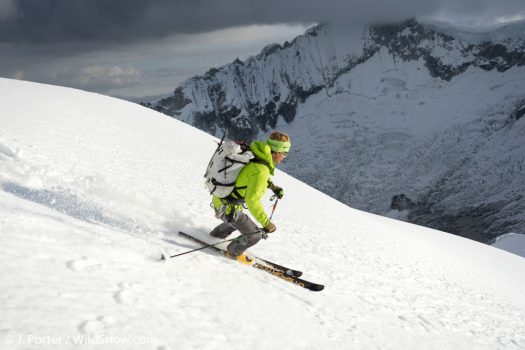
IFMGA mountain guide Mark Smiley making quick turns in afternoon sun on perfect corn with the Amazon fricken rainforest in the distance. Pure magic. (A note about the photography: I did indeed snap the shutter on the photos watermarked with my name, but it is the editing magic and nice equipment of team Smiley that makes them pop.)
The terrain on Nevado Pisco’s standard route is fairly similar to something like Mount Adams’ south side route, or the standard route on Mount Elbert. Imagine that sort of chill terrain, at 18,000 feet, in a completely foreign land, on a glacier! We all literally giggled with joy and elation. The Smileys and I have tackled a number of serious objectives together. Not long ago we huddled in a stinky, stormy, humid tent high above the coast of Alaska and fondly remembered those Pisco turns. That sort of fun, set in contrast to the altitude headaches and serac fright and calf burning ice, is what makes the entire mountain experience and life so engaging. We have access to such a broad range, all within this sport of skiing.
(Wildsnow guest blogger Jed Porter is a full-time year-round mountain guide certified by the IFMGA and is slowly putting down roots in Idaho’s Teton Valley. He and the Smileys liked their Peruvian ski adventure so much that they’re offering up a full-service, skills-improving, guided expedition to the Cordillera Blanca in 2017. See this link for full details.
Jed Porter is a passionate adventure skier and all-around mountain professional. His primary work is as a mountain guide, skiing and climbing all over the Americas and beyond. Learn more about him at his website linked below.

